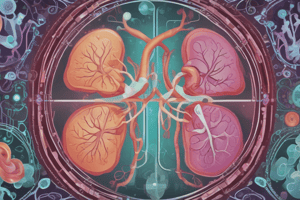Podcast
Questions and Answers
What is the main characteristic of glomerular disease according to the content?
What is the main characteristic of glomerular disease according to the content?
destruction of the glomerular components
Which of the following are causes of chronic renal failure?
Which of the following are causes of chronic renal failure?
- Loss of polyanion (correct)
- Immune mediated glomerular injury (correct)
- Activation of classic pathway
- Cell mediated immunity (correct)
Chronic renal failure can lead to anemia, metabolic bone disease, and acidosis.
Chronic renal failure can lead to anemia, metabolic bone disease, and acidosis.
True (A)
_______ is the most frequent cause of recurrent gross or microscopic hematuria.
_______ is the most frequent cause of recurrent gross or microscopic hematuria.
Match the following clinical classifications with their respective conditions:
Match the following clinical classifications with their respective conditions:
Which of the following is a major cause of nephrotic syndrome in adults?
Which of the following is a major cause of nephrotic syndrome in adults?
What is the characteristic feature observed in Glomeruli during early disease?
What is the characteristic feature observed in Glomeruli during early disease?
Membranoproliferative GN is a type of glomerulonephritis associated with nephrotic syndrome.
Membranoproliferative GN is a type of glomerulonephritis associated with nephrotic syndrome.
The pathogenesis of diabetic glomerulosclerosis is linked with generalized ____________.
The pathogenesis of diabetic glomerulosclerosis is linked with generalized ____________.
Match the glomerulosclerosis type with its characteristic feature:
Match the glomerulosclerosis type with its characteristic feature:
Flashcards are hidden until you start studying
Study Notes
Classification of Renal Disease
- Renal disease can be classified into:
- Glomerular disease
- Disease affecting tubules and interstitium
- Disease involving the blood vessels
- Cystic disease of the kidney
- Urinary outflow obstruction
- Tumors
Glomerular Disease
- Is a group of disorders characterized by destruction of the glomerular components
- One of the most common causes of chronic renal failure (ESRD)
- Mechanisms of glomerular injury:
- Immune-mediated glomerular injury
- Cytotoxic antibodies
- Activation of classic and alternative pathways
- Cell-mediated immunity
- Loss of polyanion effect
- Hyperfiltration
- Podocyst injury
Pattern of Glomerular Response to Injury
- Cellular proliferation
- Leukocyte infiltration
- Thickening of glomerular capillary loop
- Deposition of immune complexes
- Increase in GBM material
- Infiltration of abnormal material
Factor Affecting Localization of Deposit
- BM reaction:
- Membranous projection (spikes)
- Splitting of BM (double contour)
- Hyalinosis
- Fibrosis
- Epithelial cell injury
Pattern or Extent of Glomerular Injury
- Diffuse: all glomeruli affected
- Focal: some glomeruli affected
- Segmental: part of glomeruli affected
- Global: entire glomeruli affected
Classification of Glomerulonephritis (GN)
- WHO classification:
- Proliferative GN
- Non-proliferative GN
- Clinical classification:
- GN associated with nephrotic syndrome
- GN associated with nephritic syndrome
- GN associated with nephrotic syndrome:
- Minimal change disease
- Focal segmental glomerulosclerosis
- Membranous GN
- Membranoproliferative GN
- GN associated with nephritic syndrome:
- Post-infectious GN
- Rapid progressive GN
- Goodpasture's syndrome
- Anti-GBM crescent GN
- Immune complex crescent GN
- Pauci-immune crescent GN
Clinical Manifestation of GN
- Asymptomatic hematuria
- Asymptomatic proteinuria
- Acute nephritic syndrome
- Acute nephrotic syndrome
- Chronic renal failure
GN Associated with Nephritic Syndrome
- Acute post-infectious GN
- Rapid progressive GN
- Goodpasture's syndrome
- Anti-GBM crescent GN
- Immune complex crescent GN
- Pauci-immune crescent GN
Hereditary Nephritis
- A group of hereditary glomerular diseases caused by mutation in genes encoding GBM proteins
- Examples:
- Alport syndrome
- X-linked disease
- Nephritis
- Nerve deafness
- Various eye disorders
GN Associated with Nephrotic Syndrome
- Minimal change disease
- Focal segmental glomerulosclerosis
- Membranous GN
- Membranoproliferative GN
- IgA nephropathy
- Hereditary nephritis
Pathogenesis of GN
- Immune mechanism
- Genetic predisposition
- Environmental factors
- Hemodynamic changes
Diabetic Glomerulosclerosis
- Major cause of renal morbidity and mortality in diabetes
- Occurs after 10-20 years of clinical disease
- Clinical features:
- Microangiopathy
- Renal symptoms
- Proteinuria
- Glucosurea
- Progressive decrease in renal function
- Pathology:
- Capillary BM thickening
- Diffuse glomerulosclerosis
- Nodular glomerulosclerosis (Kimmelstiel-Wilson disease)
- Pathogenesis:
- Linked with generalized microangiopathy
- Metabolic defect causing hyperglycemia
- Biochemical alterations in diabetic GBM
- Non-enzymatic glycosylation
Studying That Suits You
Use AI to generate personalized quizzes and flashcards to suit your learning preferences.




